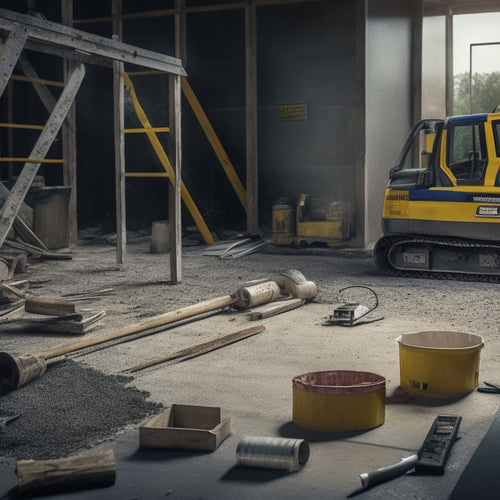
Top Rated Block Joint Sealing Tools for Renovation
Share
You'll want to invest in high-quality block joint sealing tools, including sturdy scrub brushes, efficient caulk guns, and precision putty knives, to guarantee a professional-grade seal that withstands time and harsh conditions. Top-rated joint cleaning tools, such as ergonomic debris removers and precision cleaning techniques, will also contribute to a successful seal. Furthermore, high-quality sealant applicators with adjustable flow control and ergonomic design will enhance accuracy and speed. By choosing the right tools, you'll be well on your way to achieving a durable, weather-resistant seal - and exploring the best practices and techniques will help you perfect your renovation project.
Key Takeaways
• Sturdy scrub brushes and putty knives are essential tools for clearing debris and old sealant from joints to ensure a clean surface for sealing.
• Caulk guns with adjustable flow control and ergonomic design enable efficient and accurate sealant application, reducing fatigue and improving results.
• High-quality sealant applicators with durable construction and easy cleaning features support efficient and long-lasting sealant application.
• Ergonomic and precision cleaning tools, such as joint cleaning knives and brushes, minimize risk of accidents and ensure spotless joints before sealing.
• Investing in top-rated joint sealing tools contributes to a professional-grade seal that withstands time and meets renovation quality standards.
Cinder Block Sealing Tool Essentials
You'll need a set of four fundamental tools to effectively seal cinder block joints. These tools will help you achieve a professional-grade seal that withstands the test of time and weather.
First, you'll need a sturdy scrub brush to clear debris from the joints, guaranteeing a clean surface for sealing.
Next, a caulk gun is necessary for applying sealant efficiently and accurately.
A putty knife or joint tool is also crucial for removing old sealant and preparing the joint for new sealant.
Best Sealants for Block Joints
Selecting the right sealant for your block joints is critical, as it directly impacts the longevity and effectiveness of the seal. You'll want to choose a sealant that's compatible with the type of blocks you're working with, as well as the environmental conditions they'll be exposed to. Look for sealants with high elasticity, adhesion, and resistance to weathering and UV degradation.
When it comes to block joint maintenance, you'll want to apply a sealant that's specifically designed for the job. Polyurethane-based sealants are popular for their flexibility and durability, while silicone-based sealants offer excellent resistance to extreme temperatures. Acrylic-based sealants, on the other hand, are a good choice for joints that will be subject to heavy traffic or wear.
Remember to follow proper sealant application tips, including cleaning the joint thoroughly before application, using the recommended amount of sealant, and tooling the sealant to guarantee a smooth finish.
Top Rated Joint Cleaning Tools
When you're preparing block joints for sealing, you need to guarantee they're free from debris and contaminants.
You'll want to employ effective debris removal methods that won't damage the surrounding masonry, and then follow up with precision cleaning techniques to get the joints spotless.
Effective Debris Removal Methods
By the time you start sealing, thorough debris removal is vital, and that's where top-rated joint cleaning tools come into play. You can't risk leaving behind dirt, dust, or other particles that might compromise the sealant's adhesion. Effective debris removal methods involve more than just sweeping or blowing away loose material. You need to get down to the roots of the joint, removing every last bit of debris to guarantee a strong bond between the sealant and the substrate.
When it comes to debris disposal, it's important to prioritize cleaning safety. Always wear protective gear, including gloves, goggles, and a dust mask, to prevent injury from flying particles or hazardous materials.
Top-rated joint cleaning tools are designed with safety in mind, featuring ergonomic handles, adjustable nozzles, and other features that minimize the risk of accidents. By investing in the right tools and following proper cleaning protocols, you can guarantee a safe, efficient, and effective debris removal process that sets the stage for a successful sealant application.
Precision Cleaning Techniques
To achieve a dust-free joint, you'll need to employ precision cleaning techniques that incorporate top-rated joint cleaning tools, such as wire brushes, scrubbers, and vacuum cleaners. These tools are specifically designed to remove stubborn debris and dust particles, making them essential for effective surface preparation and ensuring a strong bond between the joint sealant and the block.
When selecting cleaning methods, consider the type of debris and the joint's surface texture. For instance, wire brushes are ideal for removing loose particles, while scrubbers are better suited for tackling stubborn dirt and grime. Vacuum cleaners, on the other hand, are perfect for capturing fine dust particles.
Here are some key factors to keep in mind when choosing the right cleaning tools:
-
Surface roughness: Select a tool that can effectively remove debris without damaging the surface.
-
Debris type: Choose a tool designed to tackle the specific type of debris present in the joint.
-
Joint size: Select a tool that can effectively clean the joint's entire surface.
- Cleaning efficiency: Opt for tools that can complete the task quickly and efficiently.
Effective Block Filling Materials
When selecting block filling materials, you'll want to take into account using polyurethane foam sealants, which provide excellent flexibility and adhesion.
Alternatively, epoxy-based filling compounds can offer superior strength and durability.
Polyurethane Foam Sealants
You'll find polyurethane foam sealants to be highly effective block filling materials, offering exceptional durability and versatility in renovation projects. These sealants are ideal for filling gaps and joints between blocks, providing a strong and long-lasting bond.
When selecting a polyurethane foam sealant, consider factors such as application techniques and curing times to guarantee optimal outcomes.
Some key benefits of polyurethane foam sealants include:
-
High expansion rates to fill gaps and voids
-
Excellent adhesion to most substrates, including concrete, masonry, and wood
-
Resistance to weathering, moisture, and extreme temperatures
- Easy cleanup with soap and water
When working with polyurethane foam sealants, it's crucial to follow the manufacturer's instructions for application, including surface preparation, mixing, and curing times.
Proper application techniques will guarantee a strong and durable bond, while minimizing the risk of defects or failures.
Epoxy-Based Filling Compounds
In addition to polyurethane foam sealants, epoxy-based filling compounds offer another reliable option for effectively filling gaps and joints between blocks, providing a strong, durable bond that resists cracking and degradation.
When you choose epoxy-based filling compounds, you'll need to take into account the specific epoxy application techniques required for your project. This may involve preparing the surface, mixing the epoxy, and applying it to the joint or gap. It's crucial to follow the manufacturer's instructions carefully to guarantee a successful bond.
Epoxy-based filling compounds are available in various formulations, each with its own epoxy curing times. Some epoxies cure quickly, within minutes, while others may take hours or even days. You'll need to plan your work accordingly, considering the curing time and the environmental conditions on-site.
Properly applied and cured, epoxy-based filling compounds provide a long-lasting, watertight seal that can withstand harsh weather conditions and heavy traffic. By selecting the right epoxy-based filling compound and following best practices for application and curing, you can guarantee a durable, reliable seal that meets your project's requirements.
High-Quality Sealant Applicators
Selecting a high-quality sealant applicator is essential to ensuring a successful block joint sealing project, as it directly affects the accuracy and speed of sealant application.
You'll want an applicator that allows for precise control and even distribution of the sealant. This is especially important when working with epoxy-based filling compounds, as improper application can lead to uneven curing and compromised joint integrity.
When choosing an applicator, consider the following key features:
-
Adjustable flow control: enables you to fine-tune the amount of sealant dispensed
-
Ergonomic design: reduces fatigue and improves handling during extended use
-
Durable construction: withstands heavy use and resists corrosion
- Easy cleaning: simplifies maintenance and extends the applicator's lifespan
Tools for Smoothening Joints
To achieve a professional finish, use a tool specifically designed for smoothening joints, such as a finishing trowel or a joint knife, to remove excess sealant and create a uniform surface. These joint finishing tools are vital for effective joint smoothing techniques.
When selecting a tool, consider the type of sealant you're working with and the size of the joint. For example, a finishing trowel is ideal for larger joints, while a joint knife is better suited for smaller ones.
As you work, hold the tool at a 45-degree angle and apply gentle pressure. This will help you achieve a smooth, even finish. Be sure to wipe away any excess sealant as you go, using a clean cloth or paper towel.
By using the right tool and technique, you'll be able to create a professional-looking finish that enhances the overall appearance of your renovation project. Remember, proper joint smoothening is essential for a durable and long-lasting seal.
With the right joint finishing tools and techniques, you'll be able to achieve a high-quality finish that meets your expectations.
Frequently Asked Questions
Can Block Joint Sealing Tools Be Used for DIY Projects?
When tackling a DIY project, you're probably wondering if block joint sealing tools are up for the task. The answer is yes!
With the right tool selection, you can achieve professional-looking results. For DIY projects, benefits include cost-effectiveness and flexibility.
When choosing tools, consider the type of sealant, joint size, and surface material. Opt for tools with adjustable pressure and precision nozzles to guarantee a smooth, even application.
With the right tools and a bit of practice, you'll be sealing like a pro in no time.
Are All Block Joint Sealants Suitable for Exterior Use?
When you're selecting a block joint sealant for your project, you need to take into account whether it's suitable for exterior use.
Not all sealants are created equal, and exterior durability is vital.
You'll want to verify the sealant is compatible with the surrounding materials and can withstand harsh weather conditions.
Don't assume that a sealant suitable for interior use will perform well outside - always check the manufacturer's specifications to assure a successful and long-lasting seal.
Do I Need to Clean the Joints Before Sealing?
When it comes to sealing, you'll want to make certain the joints are properly prepared.
Do you need to clean the joints before sealing? Absolutely! Cleaning is a vital step in joint maintenance tips and sealing preparation steps.
Remove dirt, debris, and old sealant residue to assure a strong bond between the new sealant and the joint.
Failure to clean can lead to a weak seal, compromising the entire structure.
Make sure to use a wire brush or pressure washer to get the job done effectively.
Can I Use a Single Tool for Both Cleaning and Sealing?
When tackling joint sealing, you're probably wondering if you can use a single tool for both cleaning and sealing.
The answer is yes, but it depends on the tool's design and your specific needs.
A multi-functional tool can boost cleaning efficiency, but may compromise on sealing techniques.
Look for a tool that excels in both areas, or consider separate tools for best results.
Are Block Joint Sealing Tools Suitable for Old or Damaged Blocks?
When dealing with old or damaged blocks, you'll want to assess the block condition before applying sealants.
You'll find that block joint sealing tools are suitable for most blocks, but their sealing effectiveness may vary.
For instance, if blocks are severely cracked or weathered, the sealant may not adhere properly, reducing its effectiveness.
However, if the damage is minor, a good sealing tool can still provide a strong, long-lasting seal.
Conclusion
With your block joint sealing toolkit in place, you're now equipped to tackle renovation projects with confidence.
You've got the essentials, top-rated sealants, and effective filling materials to guarantee a watertight seal.
Your joints will be clean and smooth, thanks to high-quality cleaning tools and applicators.
As you smoothen out the finishing touches, your renovated space will shine, a proof of your attention to detail and expertise.
Related Posts
-

5 Must-Have Plastering Tools for Safe Renovation
You'll need a range of essential tools to tackle your plastering project safely. Invest in a variety of trowels, incl...
-

Trowel Tool Cost for DIY Home Renovation Projects
When it comes to your DIY home renovation project, you'll need to budget for a variety of trowel tools, including stu...
-

Home Renovation Safety Checklist for Homeowners
As a homeowner initiating a renovation project, you know that safety should be your top priority. Start by establishi...


